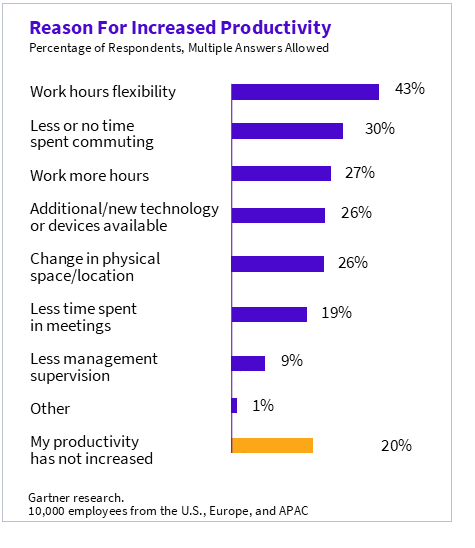
The last three years have changed the way we work in countless ways. One of the most significant changes has been the rise of remote and hybrid work models, which offer employees more flexibility in how, when, and where they work. For many workers, the ability to work from home or have a more flexible work schedule has been a game changer, allowing them to balance their personal and professional lives better.
However, while many employees have embraced the flexibility of remote or hybrid work, some employers are eager to get everyone back to the office because they feel that remote work can lead to decreased productivity and accountability.
During the World Economic Forum 2023 held in Davos, survey results of research company Gartner (10 000 respondents from the USA, Europe, Japan, China, and India) showed that employees single out flexibility as the most important reason for productivity. 43% of respondents said that flexibility in working hours helped them achieve greater productivity, and 30% mentioned that less or no time commuting enabled them to be more productive.
Some people think that flexibility is most relevant only to the young generation. While surveys show that Gen Y and Z value flexible working more than extra perks and sometimes even salary, it’s also essential to the older generation. More flexible schedules help an ageing workforce to be more productive. There is a need to distribute the workload at different stages of life – to devote time to studies, travel, childcare, or gradual retirement. And that’s precisely when remote or hybrid work is valuable.

On the other hand, it is evident that the pandemic and remote or hybrid work has weakened the ties between colleagues, and cooperation has decreased, negatively affecting the unity of teams, corporate culture, and ultimately the productivity of businesses. There are several reasons why employers started thinking of getting employees back to the office rather than continuing to work remotely:
» Working in person usually leads to better communication and collaboration among team members, which helps increase business productivity and task completion efficiency.
» Many employers believe that having employees work together in person helps to build a better sense of community and create a unique company culture.
» Some believe in-person work environments are better for fostering creativity and innovation, as spontaneous conversations and brainstorming sessions can lead to new ideas and solutions.
» Depending on the nature of the work, some employers may be concerned about the security of sensitive information or the need to comply with specific regulations or industry standards while working remotely.
» Some employers may feel more comfortable with in-person work as it allows for more direct monitoring and supervision of employees.
» In some cases, employers may have specialised equipment or resources only available in the office, making employees need to work on-site.
Billionaire Elon Musk was one of the pioneers of the going back to the office approach. Although most other companies’ managers viewed his decision to bring employees into the office publicly with caution, they quietly admired it. And when they felt the time was right, executives of other companies announced that flexibility would only decrease this year.
We have heard some of the most prominent enterprises announcing their strategies for returning to the office. Disney declared that employees would have to work from the office 4 days a week, Pfizer employees must visit the office at least 2 times a week from January, Amazon calls staff back to the office 3 days a week, etc.
In early February, The Wall Street Journal calculated that the back to office rate in the USA had risen above 50% for the first time since the pandemic began. However, often, companies choose a hybrid model with several different options: employers ask employees to work in the office for at least a few days (the employee chooses which ones), or the employer decides on which days all employees should come to the office. In practise, the manager always has the flexibility to ask the employee to be in the office on a specific day, if necessary, and also to allow work from home if the employee requests it. But the most important part prior to changing the work arrangements is to prepare a strategy for how employees will work in the future and how to communicate the return to office plan.
Ultimately, the decision about whether to work remotely or get back to the office full-time depends on the company’s preferences, the nature of the job, and the most convenient way to work for employees. Employers can offer a range of options to accommodate the needs of their employees. The key is to find a balance that works for everyone.
Subscribe to the monthly newsletter!
By clicking the “Subscribe” button above, you agree to the Terms & Conditions and Privacy Policy
2014 – 2025 Proudly designed and made in Lithuania